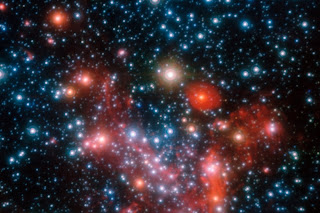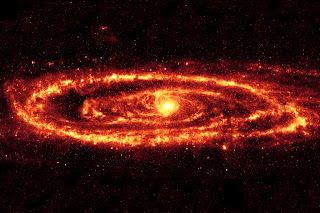IC 443 (also known as the Jellyfish Nebula and Sharpless 248 (Sh2-248)) is a Galactic supernova remnant (SNR) in the constellation Gemini. On the plan of the sky, it is located near the star Eta Geminorum. Its distance is roughly 5,000 light years from Earth. IC 443 may be the remains of a supernova that occurred 3,000 - 30,000 years ago. The same supernova event likely created the neutron star CXOU J061705.3+222127, the collapsed remnant of the stellar core. IC 443 is one of the best-studied cases of supernova remnants interacting with surrounding molecular clouds.
Astronomy, Physics, Geology, Biology, and other applications of scientific principles
Monday, November 26, 2012
Jellyfish Nebula
Sunday, November 25, 2012
deGrasse Tyson on Collapsitarians
I'm all for having a last supper at the Restaurant at the End of the Universe, but the skeptic in me also makes me question an unknown future. I need hard evidence, not speculation. Give me something substantiated.
Seagull Nebula
This image from ESO's La Silla Observatory shows part of a stellar nursery nicknamed the Seagull Nebula. This cloud of gas, known as Sh 2-292, RCW 2 and Gum 1, seems to form the head of the seagull and glows brightly due to the energetic radiation from a very hot young star lurking at its heart. The detailed view was produced by the Wide Field Imager on the MPG/ESO 2.2-metre telescope. Credit: ESO. Tap © to visit the web site.
Wednesday, November 21, 2012
The Centre of the Milky Way
The central parts of our Galaxy, the Milky Way, as observed in the near-infrared with the NACO instrument on ESO's Very Large Telescope. By following the motions of the most central stars over more than 16 years, astronomers were able to determine the mass of the supermassive black hole that lurks there.
Tuesday, November 13, 2012
Dumbbell Nebula
The Dumbbell Nebula (also known as Apple Core Nebula, Messier 27, or NGC 6853) is a planetary nebula in the constellation Vulpecula, at a distance of about 1,360 light years. This object was the first planetary nebula to be discovered by Charles Messier in 1764. At its brightness of visual magnitude 7.5 and its diameter of about 8 arcminutes, it is easily visible in binoculars, and a popular observing target in amateur telescopes.
Friday, November 9, 2012
Science Fucking Rocks!
Time-Travel is easy. All of us do it every day. But only in one direction. For thousands of years,scientists and philosophers have talked of time as a "river that flows steadily onward year-after-year". But what if there were a way to swim against the flow? Or to run down the bank ahead of the river? Might we might be able to journey back-and-forth in time just as we travel through space. The idea is not as far-fetched as it sounds. And the implications for the future are intriguing.
Super-Science , NOT Fantasy!
Ever since Einstein, scientists have considered time and 3-dimensional space not as 2 different things but as different aspects of a 4-dimensional "space-time". Quantum physicists(who study the world of subatomic particles) often find it easier to explain events by assuming time runs backward as well as forward despite however much it defies common sense.At the other extreme, cosmologists looking at the Universe on a grand scale have found that space and time can be warped by gravity and speed. Back in the 1940s, German mathematician Kurt Goedel proved that if we could warp and twist space-time enough creating what he called "Closed, Time-like Curves (CTC)" -- then we could bore tunnels through time itself. But no one knew how to do the twisting. Until black holes.
Sounds like another great addition to my regular reads.
GNANASAMBANDAN:
I have read many books regarding philosophy,religion but they doesn't satisfies the thirst of knowing the real existence of who we are? and where are we from? but little knowing of all those stuffs got a drastic change after read Buddha's concepts and thoughts, and studying the mysteries of universe paving the way to visualize the things, and understands the shapes and structures of my musings. Here i share my thoughts and things that makes me exciting and startling.
PIA16438: Hot Young Stars
The Milky Way and other galaxies in the universe harbor many young star clusters and associations that each contain hundreds to thousands of hot, massive, young stars known as O and B stars. The star cluster Cygnus OB2 contains more than 60 O-type stars and about a thousand B-type stars. Deep observations with NASA's Chandra X-ray Observatory have been used to detect the X-ray emission from the hot outer atmospheres, or coronas, of young stars in the cluster and to probe how these fascinating star factories form and evolve. About 1,700 X-ray sources were detected, including about 1,450 thought to be stars in the cluster. In this image, X-rays from Chandra (blue) have been combined with infrared data from NASA's Spitzer Space Telescope (red) and optical data from the Isaac Newton Telescope (orange). [...]
Sunday, November 4, 2012
Subscribe to:
Comments (Atom)








